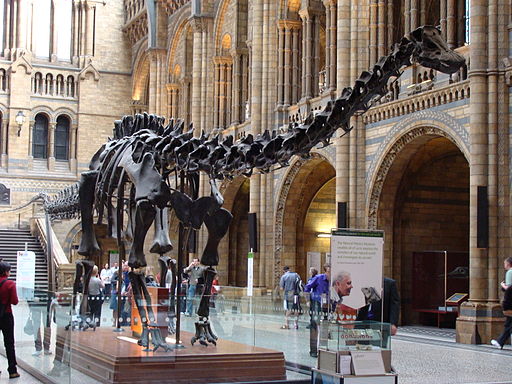
Where’s “Dippy” Gone?
‘Dippy’ is the Diplodocus that has graced the main hall of the Natural History Museum since the 1970’s. He’s the ‘friendly monster’ that has greeted thousands of families and other visitors as they have walked into one of the UK’S favourite venues. They call them ‘visitor attractions’ now, and the museum’s up there with the best.
Now, though, Dippy is going to be replaced by a huge new display – a great whale which will be suspended from the ceiling. And the great hall is now called the ‘Hintze Hall’ in honour of an important benefactor to the museum.
The Natural History Museum is in an area in London called South Kensington and it is often an introduction to other fabulous museums, such as the Science Museum and the Victoria and Albert ( the V & A ). They are all magnificent in their own way. Of course, most of these institutions are becoming modern organisations and if you look at the respective museum websites you’ll get something approaching their full story, including an artist’s impression of what a new display will look at. The Natural History Museum’s website shows, amongst other things, over a hundred years in photographs, from a stern looking Victorian policeman guarding the area ( it opened to the public in 1881 ) to a massive old elephant with huge tusks. And the hall looks pretty impressive empty – the architecture alone is amazing.
The museum isn’t just to look at, to visit and to enjoy, though. It is also a serious centre for scientific research, education, and innovation within museums. The statistics alone are impressive. Over 350 scientists work there, with 80 million specimens in safe keeping. And education and innovation are key. There is a tour of the samples held in the ‘spirit collection’ in which you might have to ‘survive a close encounter with a giant squid’. They seem to be able to mix research, learning and fun. Surely the best idea idea for a museum.
But there are dilemmas. Museums and art galleries are generally free but their funding is regularly at risk. Is sponsorship the answer? Or special exhibitions? Charging oversees visitors maybe? Some of these important debates are on the Museums Association website. They also still fear that they are failing to attract a true cross section of the population. Is commercialism, public service or traditional approaches the answer, or some combination of all three? This seems to be one of the dilemmas. And when you need money, who’s to say what’s right or wrong?
In the meantime, whether you go in person or onto their website, there will be plenty of reasons to visit the Natural History Museum for some time to come.
